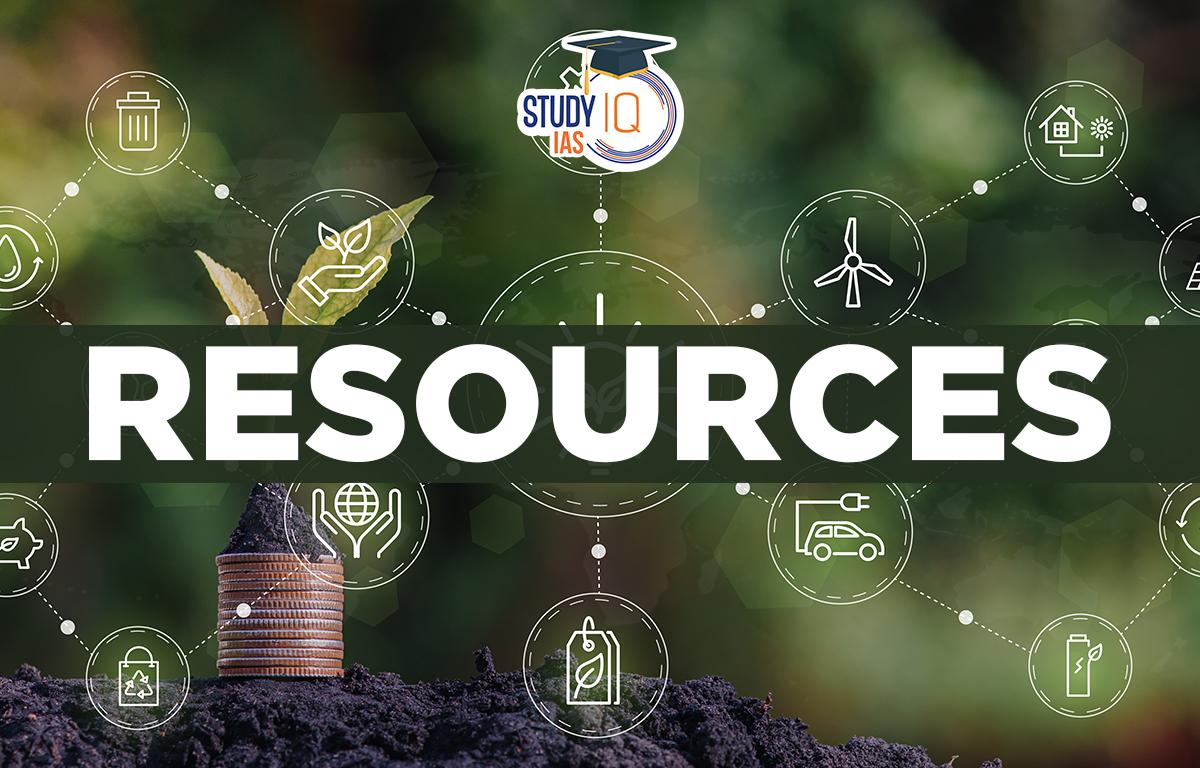Table of Contents
Resources
Resources are things that help meet our needs and make our lives better. Anything in our environment that can be used, if it is easy to access, affordable, and accepted by society can be called a resource. The important feature of a resource is that it has value. If something can’t be used or does not serve a purpose, it is not considered a resource. To be a resource, it also needs to be accessible to people. We use technology and create systems to turn natural things into resources.
Read about: Energy Resources
Types of Resources
Resources are broadly classified into natural and human resources. Resources that are drawn from nature are called natural resources. The soil, minerals, and water in lakes, rivers, and oceans, are all examples of natural resources. The resources which involve man are called human resources. People use natural resources to make buildings, bridges, roads, machinery, and vehicles, which are known as human-made resources. The resources may also be classified on the basis of origin, exhaustibility, ownership, and status of development.
Resources On the Basis of Origin
Biotic and Abiotic resources are the Types of Resources based on their origin.
1. Biotic Resources
All living elements of the environment are included in these resources. Biologic resources include forests and forest products, crops, birds, wildlife, fish, and other marine life. These resources self-replicate and regenerate, making them renewable. Coal and mineral oil are biotic resources as well, but they are not renewable.
2. Abiotic Resources
All non-living elements of the environment are included in this category. Abiotic resources include land, water, air, and minerals such as iron, copper, gold, and silver. They are finite and non-renewable because they cannot be replenished or reproduced.
Read about: Wetlands in India
Resources On the Basis of Exhaustibility
These are the types of resources on the basis of Exhaustibility.
1. Flow or Inexhaustible Resources
An inexhaustible resource is one that never depletes or runs out. Wind, sun, solar energy, tides, and geothermal energy are examples of such resources. Because they are mostly naturally occurring resources, they reappear naturally.
2. Fund or Exhaustible or Non-renewable Resources
Nonrenewable resources take a long time to form or do not form naturally. Minerals are the most common type in this category. These resources are non-renewable when we use them faster than they can be replaced. For example, fossil fuels take millions of years to form, making them non-renewable. Some resources, like radioactive elements such as uranium, can deplete naturally over time. While metallic minerals can be recycled, coal and petroleum cannot. Once they are used up, it takes millions of years for them to replenish.
3. Renewable Resources
Renewable resources can naturally replenish themselves. Resources like sunlight, air, wind, and water are always available and are not affected by how much we use. However, some renewable resources take longer to recover and can be used up if overused. A resource is considered renewable if it replenishes faster than we consume it. Compared to non-renewable resources, renewables replenish more quickly.
Read about: Land Reforms in India
Resources On the Basis of Nature of Ownership
Below are the Types of Resources on the Basis of the Nature of Ownership.
1. Individual Resources
Individual resources are those that are owned by private individuals. For instance, a house, a car, a book, and so on. Community Resources: Resources that are owned by all community members. For example, public parks, playgrounds, and so on.
2. National Resources
National resources are resources controlled by the state or government. Since the government can take private property for the public good, all resources within a country’s borders are considered national resources. Examples include railways and forests.
3. International Resources
There are international institutions that regulate some resources. These resources are called international resources. For example, ocean resources beyond 200 nautical miles from a country’s Exclusive Economic Zone belong to the open ocean. No single country can use these resources without permission from an international organization.
Read about: Coral Reef
Resources On the Basis of Status of Development
Resources are classified into four categories based on their stage of development: potential, developed, stock, and reserve.
1. Potential Resources
These are resources that have been found in a region but have not yet been utilized. For example, there is huge potential for solar and wind energy in Gujarat, most of which remains untapped.
2. Developed Resources
Resources that have been well developed and are now in use. Their quantity and quality have been determined. For example, coal and petroleum. These are resources that have been utilized by a man using technical knowledge.
3. Stock and Reserves
Stocks are resources that we can not- use yet because we lack the necessary technology and knowledge. For example, we know water is made of hydrogen and oxygen, and hydrogen can be used for energy, but we do not have the tech to do that now. Reserves are a type of stock that we can use with current technology, but we haven’t started using them yet, like certain mineral reserves.
Resources UPSC
A resource is anything that has value and is required to achieve a specific goal. The term “resource” refers to all of the materials in our environment that help us meet our needs and desires. With the passage of time and the advancement of technology, an item becomes a resource. This article discusses the resources and their types that are useful for the UPSC IAS exam.
Read about: Mountains of India


 Story of Meera Bai and Her Devotion For ...
Story of Meera Bai and Her Devotion For ...
 Desert Climate, Distribution, Climatic C...
Desert Climate, Distribution, Climatic C...
 Deserts of India Map, Features of Thar D...
Deserts of India Map, Features of Thar D...





















